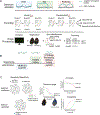The expanding vistas of spatial transcriptomics
- PMID: 36192637
- PMCID: PMC10091579
- DOI: 10.1038/s41587-022-01448-2
The expanding vistas of spatial transcriptomics
Abstract
The formation and maintenance of tissue integrity requires complex, coordinated activities by thousands of genes and their encoded products. Until recently, transcript levels could only be quantified for a few genes in tissues, but advances in DNA sequencing, oligonucleotide synthesis and fluorescence microscopy have enabled the invention of a suite of spatial transcriptomics technologies capable of measuring the expression of many, or all, genes in situ. These technologies have evolved rapidly in sensitivity, multiplexing and throughput. As such, they have enabled the determination of the cell-type architecture of tissues, the querying of cell-cell interactions and the monitoring of molecular interactions between tissue components. The rapidly evolving spatial genomics landscape will enable generalized high-throughput genomic measurements and perturbations to be performed in the context of tissues. These advances will empower hypothesis generation and biological discovery and bridge the worlds of tissue biology and genomics.
© 2022. Springer Nature America, Inc.
Conflict of interest statement
Competing Interests:
FC and EZM are consultants for Atlas Bio, Inc.
Figures




References
Publication types
MeSH terms
Grants and funding
LinkOut - more resources
Full Text Sources
Research Materials

